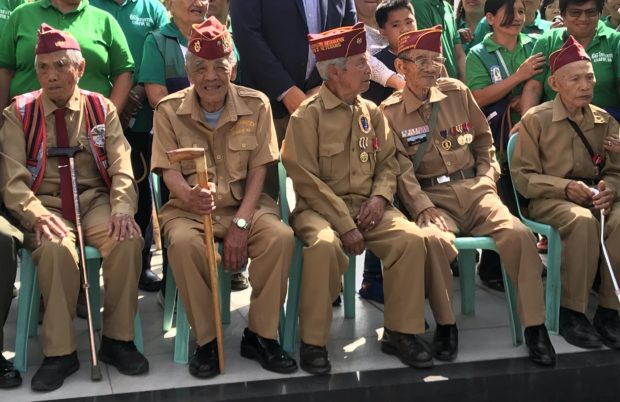
LIBERATORS The surviving members of the 66th Infantry Regiment — represented by 98-year-old Tuacan Barian, 95-year-old Epifanio Besuayan, 94-year-old veterans Garcia Wakit and Esteban Esco, and 93-year-old Alberto Bugtong — joined the 74th Baguio Liberation Day celebrations at the Veterans Park on Saturday (April 27). INQUIRER Luzon Photo / Vincent Cabreza
BAGUIO CITY– World War II veterans, all nearing 100 years old, joined the 74th Baguio Liberation Day celebration on Saturday (April 27) where they were given honors for freeing the summer capital from the occupying Imperial Japanese Army in 1945.
The surviving members of the 66th Infantry Regiment were represented by 98-year-old Tuacan Barian, 95-year-old Epifanio Besuayan, 94-year-old veterans Garcia Wakit and Esteban Esco, and the youngest of them, 93-year-old Alberto Bugtong, who managed to dance unaided for a few minutes during an Ibaloy ritual.
FREEDOM ICON World War II veteran Alberto Bugtong, 93, managed to join a ritual dance unaided for a few minutes during the 74th Baguio Liberation Day celebrations at the Veterans Park on Saturday (April 27). INQUIRER Luzon Photo / Vincent Cabreza
Numerous accounts had given credit to these veterans’ “Igorot Battalion” for conducting intelligence and guerrilla operations, which paved the way for the end of the war in the Pacific with the surrender of Japanese Gen. Tomoyuki Yamashita, commander of the Japanese occupying forces.
BAGUIO LIBERATORS An exhibit at the Baguio City Hall showcases the World War II fighters from Baguio City and Benguet province who fought to free the summer capital from the occupying Imperial Japanese Army. Baguio’s liberation on April 27, 1945 led to the surrender of the Japanese, ending World War II in the Pacific. INQUIRER Luzon Photo / Vincent Cabreza
Yamashita’s formal surrender at Camp John Hay on September 3, 1945, was also symbolic because war began there in Baguio, when it was bombarded by Japanese fighters on December 8, 1941. A day earlier, the Japanese attacked Pearl Harbor in Hawaii, which drew the United States into the global conflict.
“The heavy American presence made the Philippines a target,” said Col. Christopher Sab-it, a Baguio-born official of the Philippine Military Academy who spoke about the war during the program.
Most of the members of the 66th Infantry were from Baguio and Benguet and “their knowledge of the terrain was an advantage” against the occupying Japanese forces that governed from their headquarters at Camp John Hay, he said.
“The enemy had weapons. They (Japanese soldiers) had stamina. But our Cordillera warriors have willpower,” Sab-it said. Leading American tanks into Baguio, while American planes bombarded the city, the 66th Infantry fought their way up to Baguio, clashing with Japanese soldiers in the Benguet towns of Sablan and Tuba, and breaking through Japanese defenses along what are now Barangays (villages) Irisan and Dominican-Mirador in the city.
Tuba celebrated its own 74th Liberation Day on April 26, offering accolades to the same regiment.
The February 23, 1942 editions of Time Magazine and the New York Times “praised the troops for their bravery and skill in warfare with their bolos along the boondock trails while serving as guides for American tanks,” according to a Liberation Day exhibit at the Baguio City Hall, which displays the photographs of the veterans both dead and alive.
Sab-it said it was time for the public to reflect on their feat, given that the “nation is confronted with various challenges,” citing a looming battle against terrorism, corruption and lawlessness. /jpv